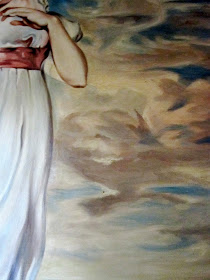This is Thomas Lawrence (1769-1830), natural genius draftsman, master of depiction of human facial expression, and gogglingly successful portrait artist of the British Regency.
This is his 1794 portrait of Sarah, age 11, born in British Jamaica. She was Sarah Goodin Barrett Moulton, but all her families called her "Pinkie."
Sarah's father abandoned her and her brothers and mother, whereupon her mother returned to England with her children. We do not know the fate of the no-good father; we can only hope he contracted some tropical disease, or angered a voodoo priestess.
Sarah's grandmother requested a likeness, because she missed her Pinkie. Mother arranged with Lawrence for this portrait. He completed it just before Pinkie died at age twelve, of "the British climate," which means bronchitis or tuberculosis.
This is Edward Stroinski in 1947, with his Genevieve.
This is Edward Stroinski's rendition of "Pinkie," which now hangs, in its original, beautifully understated frame, at the Coot Hill Family Historical Preservation Society offices. This rendition was acquired by Gene and Clara, and hung in their living room in the house in Bowmansville, a suburb of Buffalo, from about 1950.
When we switch back to Lawrence for a moment, we can enrich our ideas with some of Pinkie's cultural context. Here is his portrait of Wellington, a man we can all be grateful for. In 1794, Napoleon was just getting started on his project to conquer Europe.
This is Elizabeth Farren, who later became a Countess, but more importantly, an inspiration for future humanity trying to visualize a Jane Austen novel, either in their heads or in a film.
Mary Hamilton, another pinup girl from two hundred years before our time.
The Stroinski Pinkie moved to Marilla in 1957, and hung over the piano. (Actually, she traded places occasionally with Blue Boy over the bar cabinet; Hogwarts is nothing to't; but that's another story for another time.)
Her cheeks are pink - she is healthy - as her family was enabled by Lawrence to remember her. Think about that next time you pick up some Pasteurized milk.
With Pinkie right there on the wall, it was so easy to sit there and look at her rather than practice the piano. I did. Look at this cobalt blue. When I later saw cobalt-blue art glass, I recognized it.
This cloud-monkey is a Stroinski improvement; look for yourself all over the Lawrence; the monkey will not be there.
Scary shoe! Sometimes I woke with a start, thinking that she was tapping her foot at me and indicating the piano score I was supposed to be reading.
There's a village missing, I swear. Near where the curving road touches her billowing gown, Lawrence had another bank of trees barely revealing a rectangle of shiny white, which to me indicates buildings. Go look for yourself and see if you agree.
And the biggest mystery of all, and the reason I can't read music to this day, is this: what's going on with her forearm there?
Artistic geniuses do things for reasons of their own, we can only conclude; and we just can be grateful. Thank you, Uncle Eddie.
_by_Sir_Thomas_Lawrence,_PRA.jpg)














No comments:
Post a Comment